Exploring the Iconic Vegas Strip in Fallout
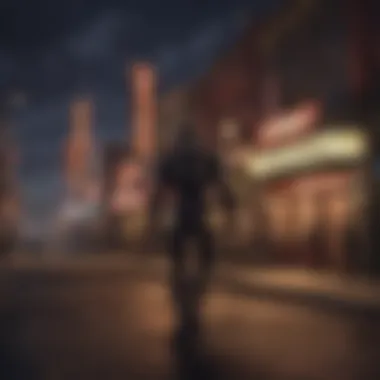

Intro
The Vegas Strip is more than just a span of neon lights and flashy attractions; it serves as a cultural touchstone in the Fallout universe. Players of the game often find themselves lost, not just in the expansive open world, but in the rich history interwoven into every crevice of this iconic location. In this guide, we will traverse the layered terrain of the Vegas Strip, peeling back the layers of history, lore, and gameplay that set it apart within the chaotic world of Fallout. With its unique blend of historical elements and futuristic twists, it reveals itself as a vivid setting that encapsulates both hope and despair.
Each section will delve into important themes like the lore, character connections, and how these facets together enrich gameplay experience. By the end, you're expected to feel more than just acquainted with the Strip; it’ll feel like a personal journey through a city battered but not broken.
Lore Insights
Overview of the Fallout Universe
To understand the significance of the Vegas Strip, one must first grasp the broader Fallout universe, which is steeped in post-apocalyptic themes and retro-futuristic aesthetics. Born from a blend of 1950s Americana and Cold War anxieties, the world of Fallout is shaped by nuclear war and its aftermath, creating a desolate landscape rife with conflict and chaos. The Vegas Strip stands as a paradox within this universe, a vibrant oasis of what once was amidst the arid wasteland that surrounds it.
Key Historical Events in the Fallout Timeline
Key historical events define the background of the Vegas Strip:
- The Great War of 2077 marked the start of the devastation.
- Pre-war Vegas was a hotspot for tourism and entertainment, attracting people from all walks of life, a stark contrast to its post-war condition.
- The fallout from the war led to the ascendance of various factions, each vying for control over the fragmented, irradiated land.
Deep Dive Into the Backstory of Major Factions and Characters
The lore surrounding the Vegas Strip is deeply intertwined with its factions:
- Caesar's Legion: A brutal autocracy that seeks to dominate the region, painting its vision of a new order with blood and iron.
- New California Republic (NCR): An attempt to bring democracy to the wasteland, albeit amidst corruption and inefficiency.
- Mr. House: The enigmatic figure running the Strip through the Securitron army, ensuring that the glitz and glamor remain, albeit under strict control.
Understanding these factions gives players a crucial insight into why the Vegas Strip is a site of contested power and a microcosm of the larger Fallout themes of survival and authority.
Gameplay Tips and Strategies
Beginner's Guide to Playing Fallout Games
For newcomers embarking on their Fallout journey, here are essential tips:
- Engage with NPCs: Dialogue often leads to quests that enrich your experience.
- Explore Off the Beaten Path: Hidden treasures and lore fill the nooks beyond major landmarks.
- Save Often: The wasteland is unforgiving; you never know when danger may strike.
Weapon and Armor Recommendations
As you venture through the Strip, consider stocking up on:
- Varmint Rifle: Great for beginners, allowing you to pick off enemies at a distance.
- Leather Armor: Light and provides decent protection for your travel.
Tips for Efficient Resource Management
Resource management can be the difference between life and death:
- Scrap Everything: Materials can be used for upgrades or traded.
- Conserve Ammo: Aim for critical hits and use melee weapons when surrounded.
Character Analysis
Detailed Profiles of Iconic Characters
- Courier: The player's avatar, whose story is shaped by choices made during the game.
- Benny: The slick, cunning character that adds layers of deception to the Strip's narrative.
Relationships Between Characters in the Fallout Series
Character dynamics greatly influence the plot:
- The tension between Caesar's Legion and NCR exemplifies the struggle for power.
- Mr. House's cold control contrasts with the emotional turmoil felt by characters navigating this world.
Character Development and Evolution Across Games
As Fallout has evolved, so have its characters. The nuanced growth of the Courier reflects the adaptive narrative society players engage with, presenting moral dilemmas and personal challenges that resonate deeply.
News and Updates
- Latest announcements: Keep an eye on developer channels for information regarding upcoming expansions or modding opportunities.
- Patch notes: Staying informed about fixes and balances can enhance your gameplay experience.
Fan Theories and Speculations
Popular Fan Theories About the Fallout Universe
Fans often ponder:
- The potential connections between locations in different games.
- Unresolved plot threads that may weave back into a future title.
Discussion on Unresolved Plot Points
Questions still linger about the fate of certain characters or factions, leading to spirited discussions amongst communities online, including platforms like reddit.
Predictions for Future Installments in the Series
The collective imagination of fans often speculates on new mechanics, settings, and storytelling innovations that could pop into the next games, expanding the Fallout legacy.
The Vegas Strip remains a canvas painted with stories of hope, despair, and the ever-present struggle for survival. Understanding its lore and characters will not just enhance your gameplay but also enrich your experience of the plot woven throughout the Fallout universe.
Preface to the Vegas Strip
The Vegas Strip serves as a vibrant microcosm, bustling with the dreams and desires of countless visitors. Designed to evoke a sense of glamour, excitement, and earthiness, this stretch is not just a destination but a narrative in itself. From its neon lights, which pulsate against the dark sky, to the towering hotels and casinos that echo tales of fortune and despair, the Strip embodies the essence of human aspirations and follies. Understanding the significance of the Vegas Strip in the Fallout universe is crucial for immersive gameplay, offering a rich tapestry of history, lore, and culture.
Historical Context of the Vegas Strip
To grasp the multiple layers of the Vegas Strip, we first need to peek into its historical backdrop. Originally a desert area, the transformation began in the early 20th century when gambling was legalized in 1931. It turned the locality into a playground for those seeking fortune—like moths drawn to a flame.
As time went on, ambitious developers erected lavish hotels and casinos. Notably, the Sands and the Stardust became beacons of entertainment in the 1950s and 1960s. These establishments not only attracted high rollers but also hosted some of the biggest names in showbiz such as Frank Sinatra and Elvis Presley.
Key Historical Milestones:
- 1931: Legalization of gambling in Nevada.
- 1950s-1960s: Rise of Las Vegas as a cultural phenomenon, attracting celebrities and tourists alike.
- 1990s: Expansion and modernization of the Strip; contemporary structures emerge, altering its skyline.
- Present: The Strip stands as a blend of nostalgia and modernity, filled with both classic casinos and extravagant resorts.
Importance in Fallout Lore
The Vegas Strip is pivotal to the Fallout series, especially in Fallout: New Vegas. It encapsulates a world of ruins that reflects the glories and pitfalls of pre-war society, imbuing every corner with stories that resonate with players. The developers have intricately woven the Strip into the game’s narrative, presenting it not just as a backdrop but as a fundamental character in its own right.
The Strip is remarkable for how it showcases the contrasting themes of capitalism and human folly. In the game, players encounter wealthy factions, such as Caesar's Legion, and see how power dynamics play out amidst a decaying world that once thrived on wealth and ambition. Thus, navigating through its neon-lit streets allows players to explore themes like ambition, betrayal, and survival—shaping their journey within the game.
"The Strip doesn’t just shine; it speaks in whispers of the past, weaving an intricate story of hopes and despairs, every building a chapter waiting to be uncovered."
This significance extends beyond core gameplay, leading to immersive quests that encourage the exploration of backstories and character arcs involving essential figures like Mr. House and the Courier. As players wander down the corridors of this digital Las Vegas, they not only uncover loot and treasures but also probe the complexities of a world fraught with moral dilemmas—a true reflection of the thematic heart of the Fallout series.
Key Landmarks on the Vegas Strip
The Vegas Strip is not just a stretch of road cluttered with flashing lights and hotels; it’s a vibrant tapestry woven from the threads of mythology, history, and the grittiness of survival in a post-apocalyptic world. In the context of Fallout, these landmarks stand as symbols of ambition and despair, attracting players not just to explore their aesthetics but also to uncover their layered significance in the game.
The Lucky Casino
The Lucky 38 Casino is the crown jewel of the strip, towering over the other establishments with an air of grandeur. Known for its pristine architecture and seemingly eternal lighting, it serves as a metaphor for both hope and hollow dreams. The casino is not only a place for gambling; it's also a pivotal location in the game's narrative. Here, players find themselves tangled in the complex web of House’s intricate schemes, directly influencing the storyline’s progression.
The Lucky 38 also stands out for its unique gameplay mechanics. The ability to manage the casino and engage with its staff injects a sense of ownership into the player's journey. Navigating through this monumental site allows players to witness the stark contrast between its luxurious facade and the desolate wasteland outside, making it a critical point of reflection in the game.
The Strip’s Iconic Neon Signs
No journey down the Vegas Strip would be complete without the dazzling array of neon signs that beckon both new visitors and seasoned gamblers alike. These signs are more than just flashy advertisements; they encapsulate the essence of Las Vegas itself—a whimsical dance between excess and decay. These glowing markers tell stories; some signal opportunities for quests, while others hint at the history tied to the locations they illuminate.
The vibrancy of these signs provides an immersive visual experience, underscoring the themes of capitalism. As players move from one flickering beacon to another, it becomes clear that these signs serve not only as navigational aids, but also as moral signposts. The allure of neon often veils the bleak realities that linger in the shadows of the Strip.
The Tops Casino: A Central Figure
The Tops Casino holds a significant position on the Vegas Strip, reminiscent of a bygone era where glamour and wealth were within reach for many. This casino offers a unique peek into the narrative intricacies of Fallout. As players step inside, they meet NPCs that shape their understanding of the underlying currents that govern the Strip.
What makes The Tops particularly fascinating is its ability to blend various gameplay elements—moral choices, faction dynamics, and combat situations. This creates a layered environment where every interaction carries weight. Players can witness the hustlers and dreamers that populate The Tops, each revealing different facets of the larger story that unfolds throughout the gaming experience.
Caesar's Palace: A Symbol of Power
Caesar's Palace stands as a colossus on the Strip, representing not just wealth but an authoritarian regime under Caesar himself. The casino’s historical reference to the real-world landmark draws in players, aligning them with its political struggles. The lavish interiors juxtaposed against the stark realities of the wasteland expose a stark dichotomy: splendor at the cost of oppression.
In the game, Caesar's Palace is more than a location; it’s a battleground for ideologies. Players find their desires for power swirling in the chaotic political landscape, leading them to make choices that carry heavy consequences. The character interactions here, especially with Caesar's legion, provide an in-depth understanding of the empire's extensive influence and its ramifications on the game’s narrative.
"To explore the landmarks on the Vegas Strip is to navigate through a labyrinth of dreams and nightmares, where each building tells a story laden with ambition and consequence."
In essence, these key landmarks provide a strong backdrop to the unfolding drama in the Fallout universe. They are lighthouses guiding players on their journey through a world that fluctuates between hope and disillusionment, a reflection mirrored in the very essence of the Vegas Strip.
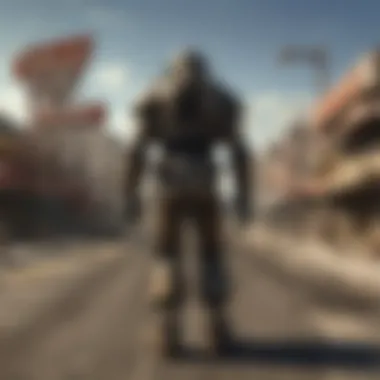
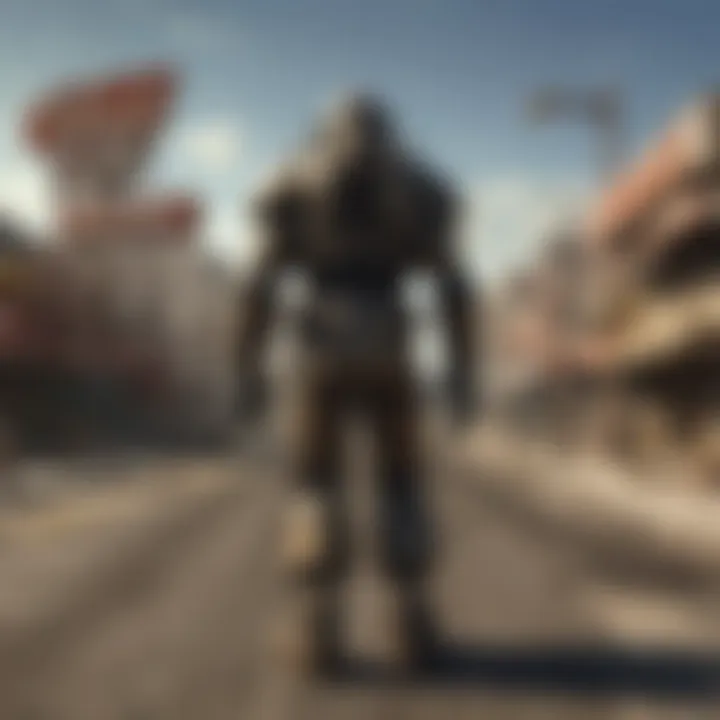
Gameplay Features of the Vegas Strip
The Vegas Strip in the Fallout universe serves not only as a visually striking locale but also as a bustling hub of interaction, story, and mechanics that significantly enrich the player's experience. Through the design philosophy that intertwines combat and narrative, the Strip plays a pivotal role in both the plot and gameplay. From the moment a player steps foot onto this neon-lit boulevard, a myriad of gameplay features come into play, enhancing immersion and presenting unique challenges.
Interactive NPCs and Story Arcs
As players traverse the sin city-like atmosphere of the Vegas Strip, they encounter a diverse cast of NPCs (Non-Playable Characters) that act as gatekeepers to the myriad of quests and lore hidden within the game. Whether you're meeting the enigmatic Mr. House, who presides over the Lucky 38, or the myriad of factions vying for control, each character contributes to the depth of storytelling.
Interactive NPCs offer quests that intertwine into broader story arcs, adding layers to player decisions. For instance, helping Yes Man can lead to different outcomes compared to siding with other factions. The moral ambiguity present in the interactions pushes players to make choices that feel weighty. A well-timed conversation can change allegiances and fortunes, echoing real-life stakes.
Often players find themselves drawn into the complexities and sometimes conflicting interests of these characters, provoking thought on issues of loyalty and power. The dialogues are crafted to make players think; they must consider their choices carefully, as those choices can ripple outward with significant consequences.
Quests and Missions Unique to the Strip
The Strip is filled to the brim with quests that distinguish it from the vast desert outside. These missions don't simply serve as tasks; they unfold stories involving betrayal, power struggles, and the desire for domination. Quests like "The House Always Wins" and "The Courier Who Broke the Bank" are essential for unraveling the narrative entwined with Vegas's shimmering façade.
Players will find missions tied intricately to each landmark, like the popular Caesar's Palace missions, where players filter through faction rivalries to achieve their own goals. Each task is laced with risk and opportunity, rewarding players for exploration by providing insights into the deeper lore surrounding the gaming environment.
Here’s a glimpse into the type of quests one may encounter:
- Faction missions: Engaging with different groups for unique quests.
- Personal quests: Stories focused on character backgrounds that use local environments.
- Contractual jobs: Simple tasks that can lead to significant plot developments.
Through engaging with these quests, the player becomes an active participant in the evolving narrative, rather than a mere observer. This level of involvement serves to reinforce the importance of the choices made by the Courier.
Exploration Mechanics and Challenges
Exploration in the Vegas Strip is less about covering ground and more about immersing oneself in a dense urban jungle filled with challenges. Players are not just walking through a hub; they are decoding a vibrant environment rife with cultural nuances and threats lurking around every corner.
Mechanics encourage players to venture off the beaten path to discover hidden places and items that tell their own stories. For instance, while strolling past glitzy casinos, one might stumble upon a collapsed building housing secrets of the past, or a secretive enclave run by radscorpions. These elements intricately weave gameplay with exploration, making even a casual stroll yield significant discoveries.
Challenges also rear their heads in various forms, whether through the need to navigate hostile territories controlled by factions or engaging in combat with mutants and rival gangs. Stealth mechanics become crucial, with players needing to utilize their surroundings to survive, creating a game where caution is as valuable as bravado.
As a wrap-up, navigating the Vegas Strip in Fallout offers a rich tapestry of gameplay features that facilitate an engaging narrative experience. With interactive NPCs, deep quests, and intricate exploration mechanics, players are challenged to think critically and remain vigilant. Ultimately, these elements coalesce to create an environment that is not only entertaining but also replayable, ensuring that every journey through the Strip brings something new to the table.
Thematic Elements of the Vegas Strip
The Vegas Strip in Fallout serves not just as a backdrop for gameplay, but as a canvas painted with vivid thematic elements that reflect the contradictions of society. This section will peel back the layers of capitalism, fame, and cultural representation that define the Strip’s essence, revealing how they influence player experience and narrative depth.
Capitalism and Decay
One of the most striking themes in the Vegas Strip is the juxtaposition of capitalism and decay. The glitz and glamor that characterized the pre-war Las Vegas clash starkly with the post-apocalyptic ruins that players encounter. The decayed architecture of luxurious casinos like Caesar's Palace, now reduced to less than a shadow of their former selves, stands as a testament to the fleeting nature of wealth.
- The casinos are a metaphor for the highs and lows of capitalism, showcasing how ambition can lead to prosperity, but also to ruin.
- As players navigate through this landscape, they witness the remnants of opulence, often accompanied by the warning signs of excess.
This theme offers players a chance to reflect on the consequences of unchecked ambition and greed, a relevant topic that echoes the complexities of real-world societal issues. The faded glory and drab surroundings evoke a sense of nostalgia and melancholy, adding layers to the gameplay experience.
"The allure of riches brings both light and shadow; the Strip embodies this duality beautifully."
Fame and Fortune: A Double-Edged Sword
Fame and fortune are often romanticized, yet the narrative in Fallout's Vegas Strip suggests a more nuanced story. Characters like Mr. House epitomize the allure of wealth and the isolation it breeds. While he may be the epitome of success and control, his very existence highlights the loneliness that often accompanies power.
- Players encounter a range of characters who are either basking in glory or struggling with the weight of their past achievements.
- The experiences of fame turning sour are illustrated through side quests where players observe the impact of once-glamorous lifestyles on individuals.
In essence, the Strip becomes a mirror reflecting the highs and lows of public life, forcing players to consider the cost of notoriety. The irony is palpable—what gives such characters a sense of worth can just as easily be their undoing, making choices impactfully poignant.
Cultural Reflections in the Game Design
The design of the Vegas Strip in Fallout is not merely aesthetic; it captures cultural reflections that resonate with the players. The visual motifs and architectural styles reinvent the classic Vegas charm with a post-apocalyptic twist. Numerous elements draw from American culture, creating a rich tapestry that feels both familiar and disturbingly surreal.
- A blend of 1950s nostalgia combined with futuristic elements invites players to consider themes of progress blended with ruin.
- Various side conversations with NPCs reveal insights into the societal values that once flourished, now twisted by the harsh realities of life in Fallout's world.
This artistic choice invites players to ponder what cultural remnants remain in a society striving to rebuild. The game questions notions of identity, belonging, and the impact of history on contemporary existence. By engaging with these reflective themes, players find themselves not just as mere observers, but participants in an ongoing exploration of cultural narratives.
In wrapping up the exploration of these thematic elements, one can appreciate how the Las Vegas Strip is much more than a mere location. It is a profound commentary on the hustle and bustle of life, reflecting both the triumphs and tragedies that come with it. Through these lenses, players are drawn deeper into the game’s narrative, fostering a connection that guarantees memorable gameplay.
Character Interactions on the Strip
Exploring the character interactions on the Vegas Strip in the Fallout series opens a window into a vibrant world teeming with life, motivations, and consequences. Unlike many gaming environments where interactions can often feel superficial, the characters in this part of Fallout stand out with depth and substance. This section reveals how such interactions offer players the chance to engage with the lore while making meaningful choices that shape the overall narrative of the game.
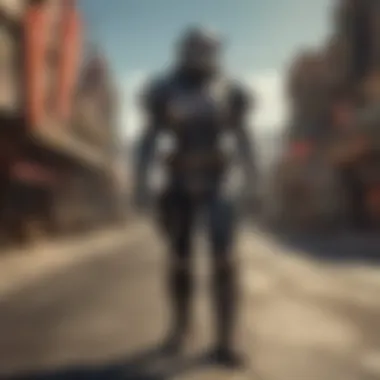
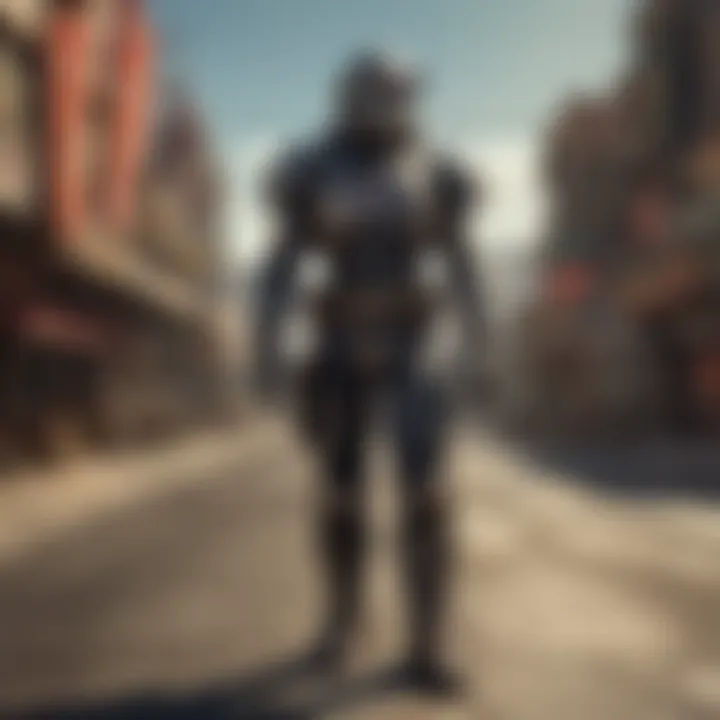
Key Characters and Their Roles
The Vegas Strip comprises a colorful cast of characters, each with unique roles that contribute to the overall narrative.
- Mr. House : The enigmatic figure overseeing the Strip, Mr. House is a remnant of pre-war America, embodying the ambition and corruption that once defined Las Vegas. Players can choose how to interact with him—either as an ally or a foe. His motivations drive significant parts of the storyline, presenting dilemmas surrounding loyalty and power.
- Caesar : The powerful leader of the Caesar's Legion, Caesar presents a stark contrast to the capitalist ideals represented by Mr. House. Players must navigate their relationship with him, weighing loyalty against moral compass. His harsh tactics create immense pressure on the Courier, throwing challenges that call one’s ethics into question.
- Benny : A charming yet treacherous character, Benny is pivotal due to his attempts to eliminate the Courier early in the game. His duality—being both cunning and charismatic—leads to numerous paths the player can take in their quest for vengeance or reconciliation.
Engaging with these characters is not merely about advancing the plot; it’s about immersing oneself in a dynamic web of relationships that can lead to vastly different gameplay experiences. Each interaction can open new quests, reveal hidden story elements, or lead the player to unexpected allies or enemies.
The Courier's Journey: Choices and Consequences
The essence of character interactions on the Strip can be boiled down to the choices players make throughout their journey. The ramifications of these choices echo throughout the gameplay, creating a ripple effect that can alter the course of the story and the fate of the characters involved.
- Consequential Decision-Making : Every choice the Courier makes can lead to varying outcomes. For instance, siding with Mr. House can usher in a new era of prosperity under his rule. Conversely, aligning with the NCR or Caesar’s Legion can plunge the Strip into chaos. This sort of decision-making propels the narrative forward and underscores the weight each interaction carries.
- Moral Dilemmas : Engaging with characters often presents ethical challenges. Take the scenario with Benny—players can choose to confront him directly or take a subtler approach, possibly forging an alliance with him instead. Such choices force players to navigate their values and decide what kind of protagonist to embody.
- Dynamic Outcomes : The interplay between characters results in a fluid story. Players may find that actions earlier in the game manifest in unexpected ways later on, reinforcing the idea that every interaction, no matter how trivial, can have lasting implications. For example, winning over or alienating key characters can significantly impact access to resources, support in battles, or outcomes in pivotal quests.
“In the Fallout universe, every choice counts because every character is a piece on the grand chessboard of the Strip, influencing the outcome in ways that are often surprising.”
Overall, character interactions serve as the lifeblood of the narrative on the Vegas Strip, providing a lattice of choices that intertwine with the game’s core themes. As players navigate this landscape, they find themselves not just participants but architects of their destinies within the rich tapestry of the Fallout universe.
Comparative Analysis with Real-World Las Vegas
When discussing the Vegas Strip in the context of the Fallout universe, it becomes essential to compare it with its real-world counterpart. This comparison illuminates how the game designers have extrapolated from actual locations to design an atmosphere that's both familiar and surreal. The Vegas Strip serves more than just an aesthetic backdrop; it encapsulates elements of culture, economics, and architecture that resonate deeply with those who have experienced Las Vegas in reality.
Similarities in Design and Structure
The design of the Vegas Strip in Fallout: New Vegas echoes many recognizable features of the actual Las Vegas. The layout is deliberately designed to provide a sense of scale and grandeur, mirroring the opulent casinos and dazzling lights of the real city. Key similarities include:
- Iconic Casino Designs: Just like Las Vegas, the in-game casinos embody a mixture of luxurious themes, harkening back to historical and fantasy roots. For instance, the Lucky 38 Casino parallels venues like the Stratosphere, presenting a tall structure that dominates the skyline, engaging players visually and thematically.
- Neon Lights and Aesthetic Choices: The vibrant neon signage is a hallmark of both realities. In the game, these lights are reminiscent of classic Las Vegas imagery, contributing to an immersive atmosphere that captures the allure of nightlife. The game developers successfully replicate this visual delight, sparking excitement in players as they traverse its streets.
- Landmarks and Layout: Major landmarks, such as Caesar's Palace and the Nipton Road, are inspired by their real-life counterparts. The careful arrangement of roads and buildings allows for exploration that feels substantive, drawing players into the narrative while retaining a benefit of familiarity with the geographical structure.
The thoughtful re-creation of these elements highlights how vital they are in establishing a rich environment that players can explore and connect with on multiple levels.
Contrasts in Socioeconomic Dynamics
Despite the apparent similarities, there are stark contrasts in the socioeconomic dynamics between the real-world Vegas and its Fallout counterpart. In Fallout: New Vegas, players encounter a post-apocalyptic version of the Strip defined by societal decay and economic disparity. Here are some significant contrasts:
- Presence of Factions: In the game, various factions like the New California Republic and the Caesar’s Legion vie for control over the Strip. This notion of factionalism diverges sharply from real-world Las Vegas, where competition among casinos is driven primarily by commerce and entertainment rather than conflict for power.
- Economic Decline: Unlike the thriving, glittering reality of Las Vegas, the Strip in Fallout reflects the consequences of nuclear fallout, presenting the city as a shadow of its former self. Players witness abandoned properties and societal collapse, diverging greatly from the bustling energy and tourism that characterizes Las Vegas today.
- Moral Ambiguities: The game introduces moral choices, forcing players to navigate a web of ethical dilemmas, often leading them to question their role in a decayed society. This element of decision-making starkly contrasts with the entertainment-centric experience of the real Vegas, where guests usually seek leisure and personal enjoyment without moral ramifications.
Impacts of the Vegas Strip on the Overall Fallout Narrative
The Vegas Strip occupies a unique space within the Fallout universe, serving as more than just a backdrop for adventure. It's a living, breathing testament to both the dystopian echoes of pre-war America and the creative liberties embraced by its developers. In this section, we delve into how the Strip not only enhances gameplay but also weaves complex narratives that resonate with players long after they log off.
Influence on Game Mechanics
In the context of game mechanics, the Vegas Strip is a veritable goldmine of innovative design. The developers ingeniously integrated elements that elevate the gaming experience. Players navigate a maze of casinos and bustling streets, each location offering distinct gameplay experiences.
- Quests: Many quests are tailored around the Strip's key locations, pushing players to engage in a variety of activities. Whether it’s trying your luck at the Lucky 38 or uncovering secrets in the Tops Casino, each scenario presents unique challenges.
- Economics: The in-game economy shifts significantly in the Vegas Strip compared to other areas. The abundance of caps (the currency used in Fallout) and the gambling features provide various ways for players to amass wealth, thus affecting their strategy and progression.
- NPC Interactions: The Strip is bustling with characters that facilitate dynamic storytelling. Each Australian who wanders through the neon-lit streets has a part to play, contributing to an intricate web of narratives that keep players engaged.
What stands out is how the mechanics of chance and risk reflect the real-life allure of Las Vegas. Players must make choices that either help them strike it rich or lead them to financial ruin, perfectly encapsulating the fame and fortune theme that permeates the Strip.
The Role in Player Immersion
The Vegas Strip plays a paramount role in immersing players in the Fallout universe. The vibrant colors, the character animations, and the engaging soundscapes all contribute to a sensory experience that transports players into a post-apocalyptic nightlife.
"The Vegas Strip acts as an oasis amidst the arid wasteland, capturing the essence of a lost world where dreams and hopes are indulged, waiting to be reclaimed."
Some critical elements showcasing player immersion include:
- Atmosphere: The Strip’s design incorporates classic Las Vegas aesthetics — glitzy neon lights, lavish sets, and crowded venues, which remind players of the real-world equivalent. This not only grounds the game in reality but also enhances emotional attachment to in-game locations.
- Storytelling: Through environmental storytelling, players find themselves piecing together the history of the Strip. Abandoned areas tell stories of sin and fortune – they allow wanderers to predict past events and experience the consequences of those buried narratives themselves.
- Interactivity: Players feel an amplified sense of agency when exploring. Choices made during interactions affect the storyline, leading to different outcomes throughout the Strip. This interplay of actions and consequences deepens engagement and loyalty to the game's narrative.
In sum, the Vegas Strip is not just a locale within the Fallout landscape; it’s a vibrant tapestry of stories and gameplay elements. Its multifaceted nature significantly impacts the overall narrative, ensuring that players are both entertained and immersed in the world of Fallout.
Culmination
The Vegas Strip holds a significant place within the Fallout universe, serving not just as a backdrop but as a pivotal element that shapes the narrative and gameplay. Throughout this article, we've hiked through its vibrant landscape, fully grasping the complex ties it holds to both historical context and its thematic richness. It has managed to be a mirror to real-world dynamics while simultaneously reflecting the essence of survival and choice—the hallmarks of the Fallout series.
Final Thoughts on the Strip’s Legacy
The legacy of the Vegas Strip in Fallout is multi-layered and profound. From its dazzling neon lights to its shadowy alleys, it encapsulates the duality of ambition and ruin. Players scout these glittering establishments like the Lucky 38 and Caesar’s Palace, not only for the thrill of interaction but to unravel the profound stories seeded in their very foundations. This blend of facade and substance has, over time, transformed this locale into a character of its own. The Strip challenges players to account for their choices at every corner, making it a memorable hub that straddles the past and future.
Future of the Vegas Strip in Gaming
It is evident that the popularity of the Vegas Strip transcends traditional gaming boundaries. As developers continue to pull inspiration from real-world locations, future installments in the Fallout series may delve deeper into the Strip’s history or even expand upon untapped narratives. Innovations in technology, particularly virtual reality, could pave the way for a richly immersive Vegas experience, allowing players to not just stroll visually but actually feel the pressure of their decisions amid the casino chaos. What lies ahead for this iconic setting might reshape how fans perceive and interact with the Fallout universe. As virtual landscapes grow ever more expansive and detailed, the Vegas Strip stands poised at the crossroads of nostalgia and ingenuity.
In the world of Fallout, the Vegas Strip is more than a destination; it’s a testament to the choices we make and the futures we build, reflecting the complex reality of ambition and decay that exists both in-game and in life.
By weaving together historical resonance, captivating lore, and rich gameplay experiences, the Vegas Strip ensures that it will remain a focal point for both players and storytellers for years to come.







